Connecting rural Nepalese farmers to the market through Interactive Voice Response (IVR) service
Read the full story.
Read the full story.
East and Southern Africa is a climate hotspot, with more than US$45 billion in agricultural production at risk from higher temperatures, shorter growing seasons and more extreme droughts and floods. Maize, a staple crop covering up to 75% of cropland in parts of the region, is particularly vulnerable and is projected to face yield declines of 15%, among other climate impacts if no adaptation measures are taken. Many of the affected areas already have serious levels of hunger and malnutrition, with the highest burden experienced by women and youth from marginalized and vulnerable communities. If these systems are sustainably diversified, they can contribute to stabilizing regional and global agrifood systems.
The next decade will be critical for strengthening food, land and water systems in East and Southern Africa. The agribusiness ecosystem for both regions has been identified as a critical engine for agricultural and economic development, climate change adaptation and gender and youth empowerment. Investment in innovation, capabilities and supportive environments will be essential for driving sustainable growth.
Objective
This Initiative aims to support climate-resilient agriculture and livelihoods in 12 countries in East and Southern Africa by helping millions of smallholders intensify, diversify and reduce the risks in maize-based farming through improved extension services, small and medium enterprise development, supporting governance frameworks and increased investment with a gender and social inclusion lens.
Activities
This objective will be achieved through:
Since 2021, CIMMYT, in partnership with the International Livestock Research Institute (ILRI), the French Agricultural Research Centre for International Development (CIRAD), and the University of Zimbabwe’s Department of Veterinary, has been working in rural communities of Zimbabwe, as part of the Livestock Production Systems in Zimbabwe (LIPS-Zim) project. The activity is led by Zimbabwe’s Department of Research and Specialist Services and is at the forefront of introducing new agricultural innovations to local farmers.
One of their most impactful initiatives has been the intercropping trials involving maize and various legumes including jack bean, mucuna, lablab, and pigeon pea. This groundbreaking approach has not only transformed the lives of farmers but has also had a positive impact on the overall health of livestock.
Various leguminous fodder crops have been promoted widely as sources of high-quality protein feed in mixed crop-livestock systems of Zimbabwe. However, to diversify and increase the options for the drier regions, the LIPS-Zim project is testing new leguminous crops such as jack bean and pigeon pea, which are well-adapted to dry conditions.
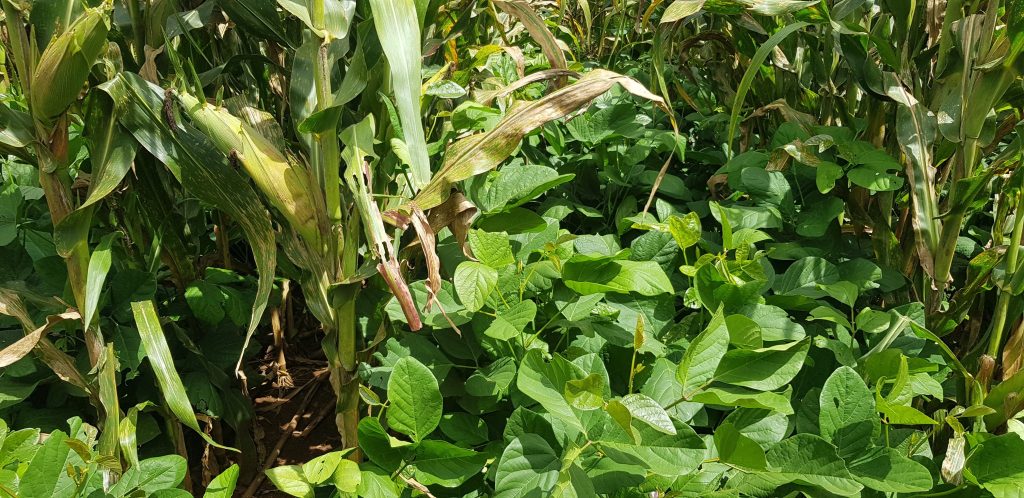
Netsai Musekiwa, a farmer in the town of Mutoko, has been part of the LIPS-Zim project for the past two seasons, and is currently conducting intercrop trials with jack bean. “Since I started intercropping maize with jack bean, I have been amazed by the results and will continue on this path. The jack bean plants have shown strong tolerance to prolonged dry spells and heat stress,” she said. “Next season, I plan to extend my plot to harvest more jack bean.” These words of encouragement on intercropping maize with jack bean have also been largely echoed by many other farmers in Mutoko and Buhera during the feedback meetings held in October 2023.
What is intercropping and how beneficial is it to farmers?
Intercropping is an agricultural practice of growing two or more crops together on the same field simultaneously to maximize land use and enhance productivity. As different crops have different growth patterns and nutrient requirements, intercropping can help optimize resource utilization and boost overall crop output.
In addition, intercropping reduces the risk of climate induced crop failure as well as minimizing pest damage, enhances soil fertility by diversifying the root system, and can provide additional income streams to farmers.
The science behind jack bean and pigeon pea
Jack bean (canavalia ensiformis) and pigeon pea (cajanus cajan) are leguminous crops valued for their nitrogen-fixing abilities which aides in improving soil fertility. Both jack bean and pigeon pea have deep root systems, making them ideal candidates for the dry semi-arid conditions in Zimbabwe.
Pigeon pea is known for its drought-tolerance and produces edible seeds used in various culinary dishes and is a source of both food and feed. Jack bean is used as a forage crop for livestock, providing nutritious feed.
“Jack bean seeds contain a toxic compound called canavanine, which can be harmful when consumed in large quantities or not properly processed. To make jack beans safe for consumption, it must be boiled, soaked, or fermented,” said Isaiah Nyagumbo, cropping systems agronomist at CIMMYT. “We have introduced many farmers to the best practices for handling jack beans and have opened up new possibilities for its utilization in sustainable farming practices.”
While some farmers were intercropping with jack bean, others explored pigeon pea as an alternative. “I liked the intercropping of maize and pigeon pea on my plot. I am assured of getting nutritious food both for my family and livestock. After harvesting, I usually take the branches, then put them in the shade and dry them to retain the nutritional value. I occasionally give some to my goats during the dry season when feed from natural pastures is scarce, and my goat herd has risen to 12 goats,” said Fungai Kativu, a farmer in Mutoko.
Building capacity of local farmers
To narrow the knowledge gap and highlight the potential of such feed options, LIPS-Zim has also been spearheading the establishment of community level learning centers. These centers are a knowledge hub to local farmers, providing practical knowledge, facilitating the sharing of different perspectives while nurturing working as groups with a common vision. This “farmer learns by seeing” approach has been a success in the community.
Through this initiative, farmers have not only witnessed increased productivity but have also gained the necessary skills and knowledge to adapt to the changing agricultural landscape. “Intercropping leguminous crops with maize has shown great potential in improving food security and livestock feed production in Zimbabwe’s farming communities, especially in areas prone to heat and drought,” said Nyagumbo.
British Prime Minister Rishi Sunak announced a new partnership between the CGIAR and the British Government at the Global Food Summit.
Read the full story.
The LIPS-ZIM program led by CIMMYT and partners, addresses livestock disease challenges in Zimbabwe. This collaborative effort aims to enhance livestock productivity and control diseases affecting smallholder farmers.
Read the full story.
CIMMYT’s partnership with the Government of India, which spans more than five decades, is one of the longest and most productive in the world.
In October, a group of about 18 scientists from Bihar Agricultural University (BAU), Indian Council for Agricultural Research (ICAR), and Dr. Rajendra Prasad Central Agricultural University (RPCAU) visited CIMMYT headquarters in Mexico to participate in the course on “Innovation in Agri-food Systems through the Hub Model”.
Read the full story.
Zimbabwe’s agricultural sector is predominantly subsistence-oriented, with maize as the main staple crop and limited use of external inputs. To promote sustainable and climate-smart agriculture, Zimbabwe has developed a 10-year framework (2018-2028) that emphasizes the adoption of climate-smart agriculture (CSA). However, the adoption of CSA practices remains limited in the country. Agroecological practices (AE) and the systemic perspective embedded in agroecological approaches hold great potential to address climate change and enhance agricultural sustainable intensification in Zimbabwe. RAIZ was conceived as the research component of the “Team Europe Initiative” (TEI) on “Climate-Smart Agriculture for Resilience Building”, formulated by the European Union (EU) delegation in Zimbabwe together with its member states.
Led by the French Agricultural Research Centre for International Development (CIRAD), in partnership with CIMMYT and the University of Zimbabwe, with funding from the European Union, RAIZ operates along a gradient of declining rainfall from Murewa in Natural Region II to Mutoko in Natural Region IV. Both districts are in the Mashonaland East province. Under RAIZ, CIMMYT leads Work Package 3 which involves ‘developing the capacity of extension and advisory services on agroecological approaches’ is actively involved in research and development activities, including the creation of training materials and the establishment of on-farm trials. In efforts to address challenges associated with low soil fertility on Zimbabwe’s granitic sandy soils. CIMMYT scientists working on RAIZ are testing the contribution of organic fertilizers and conservation agriculture in building up soil organic carbon and bringing back soil life to these mostly dead soils. These efforts aim to support farmers in adopting sustainable and climate-smart agricultural practices, ultimately contributing to the long-term resilience and prosperity of Zimbabwe’s agricultural sector.
Key objectives
The overall objective is to support government in the development and implementation of scientifically tested agroecological approaches which will enhance agricultural production and resilience to climate change in Zimbabwe.
In addition, the project focuses on protecting the environment and reducing greenhouse gas (GHG) emissions. It will provide scientific evidence and experience for the design of climate-smart agriculture (CSA) at the plot, farm, and landscape levels, contextualized for mixed crop–livestock farms under sub-humid to semi-arid environments.
New drought-resistant sorghum varieties bring hope for farmers in Africa
Scientists have identified drought-resistant, high-yielding sorghum genotypes that have the potential to revolutionize agriculture in dry regions of Africa. Sorghum, a staple food for millions in sub-Saharan Africa, has long been threatened by devastation from drought.
But now, researchers from the African Centre for Crop Improvement, the Institute of Agricultural Research (IAR), the International Maize and Wheat Improvement Center (CIMMYT), and the University of Life Sciences have discovered genetic resources that thrive under adverse conditions, yielding promising results and providing hope for a future that is more sustainable.
The study looked at 225 sorghum genotypes in various conditions, including non-stressed conditions and pre- and post-anthesis drought stress. The researchers used advanced statistical analysis, such as the additive main effects and multiplicative interaction (AMMI) method, to identify the most resilient and high-yielding genotypes.
The results revealed a vast diversity in the genetic resources of sorghum and provided a pathway for selecting promising genotypes for regions prone to drought. In addition, the study highlighted the significant impact of environmental conditions on grain yield, with genotypes showing variable responses to different growing environments.
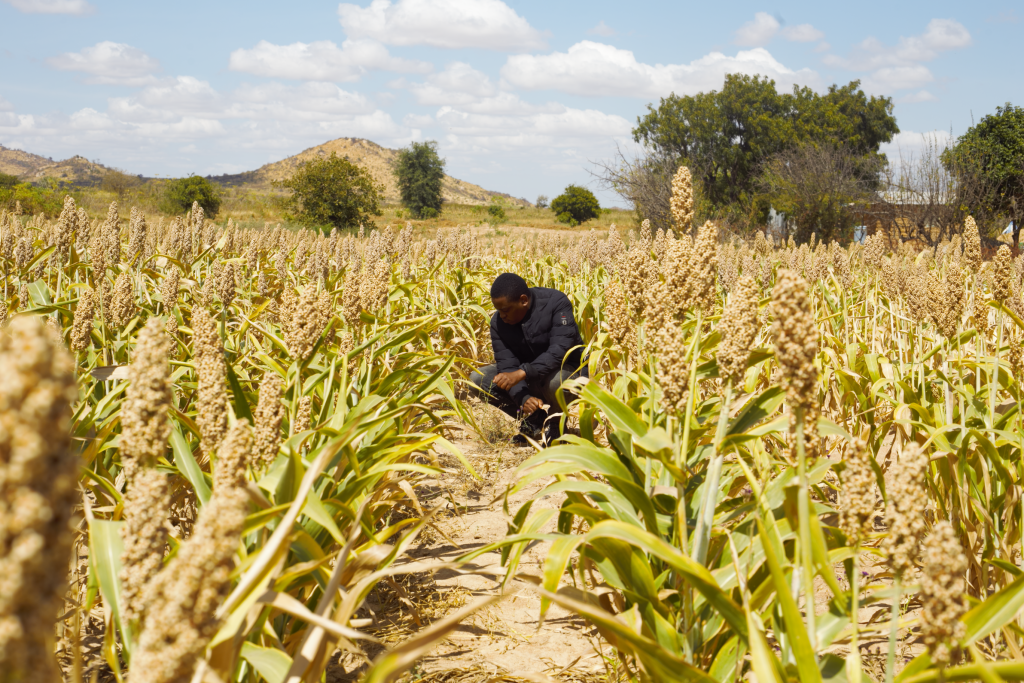
For example, genotypes G144 (Kaura Short Panicle-1) and G157 (Kaura Mai Baki Kona) displayed higher grain yield in drought-stressed environments and were among the top performers. Not only do these genotypes outperform registered cultivars, but they also possess traits valued by farmers, making them ideal candidates for future breeding programs. In addition to drought tolerance, genotypes G119 and G127 displayed remarkable stability and high yield under non-stressed conditions, showing their potential as all-around performers in a variety of environments.
Farmers in dry areas of sub-Saharan Africa that are characterized by pre- and post-anthesis drought stress stand to gain a great deal from these newly identified sorghum strains. Adoption of these high-yielding and drought-resistant genotypes could increase food production and strengthen farmers’ resilience against the effects of climate change.
The findings of these super sorghum genotypes offer farmers facing the challenges of climate change a glimmer of hope. By adopting these new drought-resistant strains, African farmers can improve their food security and strengthen their communities, paving the way for a more resilient and sustainable future.
In a collaborative effort to tackle global food challenges, Melinda Yerka, an associate professor in the Department of Agriculture, Veterinary & Rangeland Sciences and her team are partnering with sorghum breeders at the CIMMYT. Together, they’re extending the reach of sorghum varieties to developing nations.
Read the full story.
Representatives from various sectors in Tanzania met to discuss the challenges and opportunities in the country’s groundnut value chain, with the aim of establishing a platform for dialogue among stakeholders involved in groundnut production and distribution.
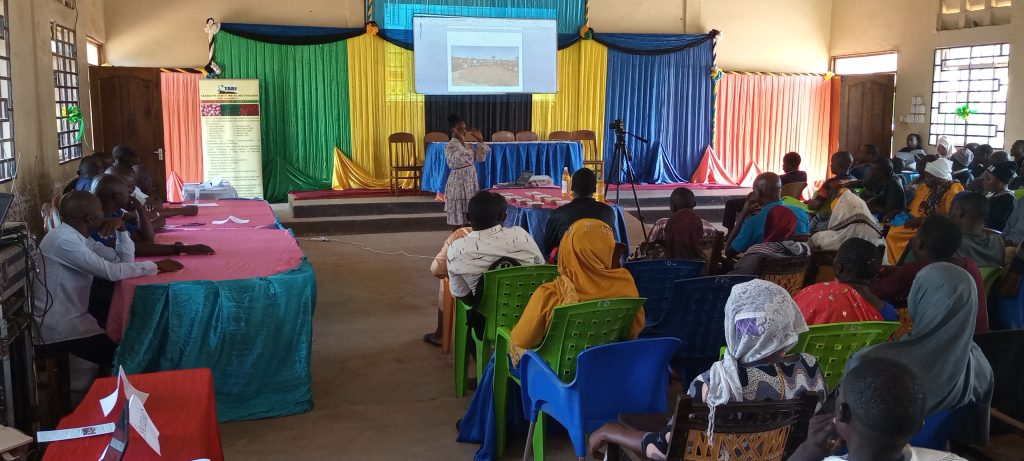
The meeting was organized by TEMNAR Co. Ltd., and brought together key stakeholders including farmers, government officials, research institutes, NGOs, and partners such as Ruvuma Commercialization and Diversification of Agriculture (RUCODIA), SWISSAID, and Vodacom. All participants affirmed the meeting’s overall impact and significance, acknowledging that the event would help lay a strong foundation for the growth of groundnut farming, particularly in Mtwara and Lindi regions.
The meeting featured presentations from scientists at the Tanzania Agricultural Research Institute (TARI) — who addressed topics such as groundnut agronomy and seed technology — and representatives from TEMNAR, who outlined strategies to facilitate effective collaboration among stakeholders and achieve mutually beneficial outcomes. Discussions centered on topics such as groundnut varieties, market demands, and the importance of quality and cleanliness throughout the production process. Trust in business relationships was identified as a key factor for success.
Participants at the meeting shared innovative ideas and identified opportunities for strengthening the sector. They highlighted, for example, the need for aggregators to specify their groundnut volume requirements and the application of simple technologies — such as hand push planters and threshing machines — to increase production efficiency. They also emphasized the importance of planting new TARI-bred groundnut varieties to meet market demand, and the establishment of additional seed multiplication farms to increase seed availability.
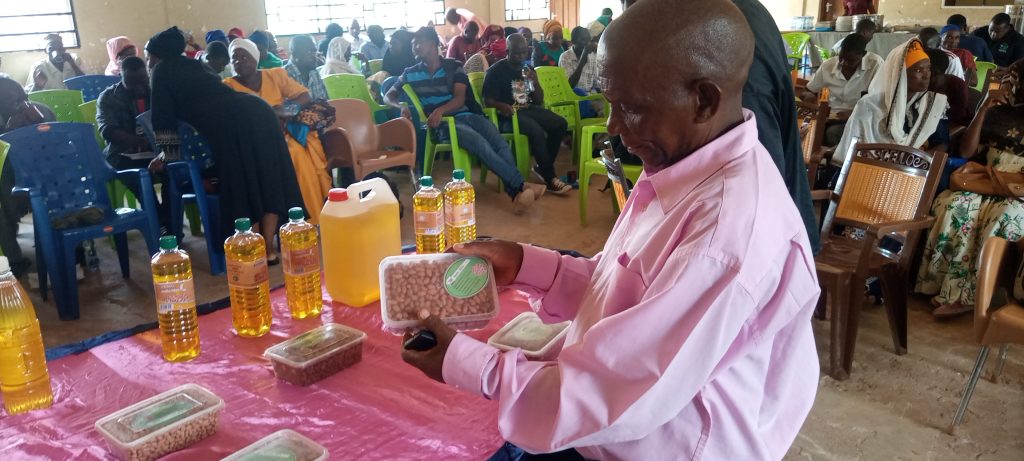
Another key component of the meeting was assessing the challenges faced by local groundnut farmers. These include the shortage of good groundnut seed, limited agronomical knowledge, and the labor-intensive nature of planting, harvesting, and picking the crop. To address these challenges, participants suggested making agricultural inputs and tools more accessible to farmers, conducting technology demonstrations, and establishing seed multiplication farms across different districts.
Both farmers and aggregators expressed their commitment to making changes in their farming practices; aggregators are now able to access groundnuts easily through phone calls, while farmers enjoy improved access to markets and better prices. A number of follow-up actions have also been planned as a result of the meeting, such as product buyback initiatives during the harvest season and the establishment of field days to help reach more farmers and aggregators at the local level.
As the effects of climate change intensify, rain dependent crop production is becoming more challenging for smallholder farmers in Malawi, Tanzania and Zambia. Farmers often experience either too little or too much rain to effectively grow their crops, which means growing crops under irrigation is becoming key to building resilience to climate shocks. However, smallholder farmers often lack the access to equipment and skills to implement low-cost irrigation technologies.
The Accelerated Innovation Delivery Initiative (AID-I) implemented by the International Center for Maize and Wheat Improvement (CIMMYT) with funding from the United States Agency for International Development (USAID) has partnered with Total LandCare (TLC) Malawi and Zambia to promote Sustainable Intensification practices in eastern and central Malawi. TLC conducted a training session on using treadle pumps for irrigation plot layout in Mumbi Village, Petauke District, Zambia.
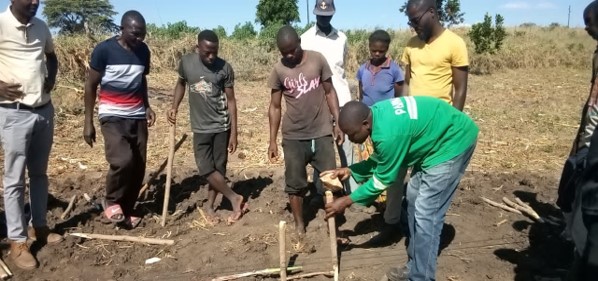
Letting gravity do the work
The irrigation system operates on the principle of pumping water manually from a low point to a high point from which the water then flows by gravity through a system of channels to irrigate crops.
Properly managed, treadle pump irrigation can improve household food security, income, nutrition, and health sustainably without detrimental effects to the environment.
The training educated 12 farmers in establishing an irrigation layout using gravity-fed basins, with water pumped from a stream downhill using a treadle pump. Participants learned how to erect channels that directed water into basins.
During practical irrigation training in Muya village of Mondolo camp, Petauke district, one of the farmers, Magret Tembo said, “This method of irrigation will negate the burden associated with use of watering cans, a practice which has been giving us backaches. Through this technology, we will experience increased production through better water management and increased area coverage.”
Following the setup demonstration, participants received practical guidance on various aspects of irrigation and crop management, covering such topics as planting techniques and effective fertilizer use, and application of pesticides and fungicides.
Inexpensive and durable
“Treadle pump irrigation offers tremendous opportunities to dramatically increase agricultural production while enriching the livelihoods of many resource-poor farmers,” said Zwide Jere, Co-founder/Managing Director of TLC.
Treadle pumps are inexpensive, so individuals can afford to purchase one and they are durable and easy to maintain, so one pump will work for years for individual households.
“The pumps are also designed to work in many environments,” said Paul Malambo, Country Manager for TLC Zambia. “So, over the years, TLC has been able to distribute the pumps in Malawi, Mozambique, Tanzania and Zambia.”
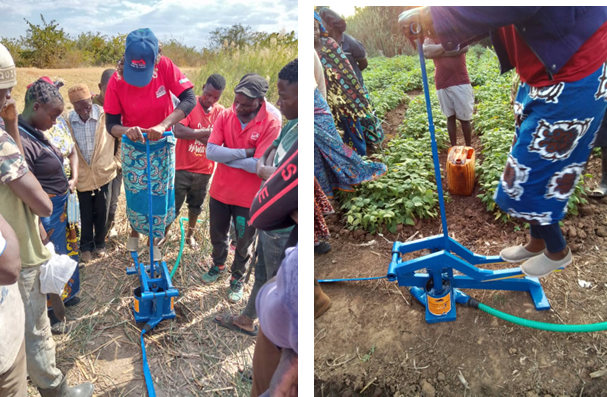
“Providing access to technical knowledge and support for under-utilized land, water and labor resources is an important part of the AID-I project, said Kevin Kabunda, CIMMYT lead for the AID-I. “As is collaboration with local partners like TLC who facilitate the dissemination of expertise.”
TLC is a registered non-governmental organization based in Malawi and active in Zambia. Its mission is to empower self-reliance and prosperity for rural households in the Southern Africa region.
During his recent visit to Beijing, CIMMYT Director General, Bram Govaerts highlighted China’s remarkable investment in science and technology for food security, highlighting the positive impact on crop production and resilience to supply chain disruptions.
Read the full story.
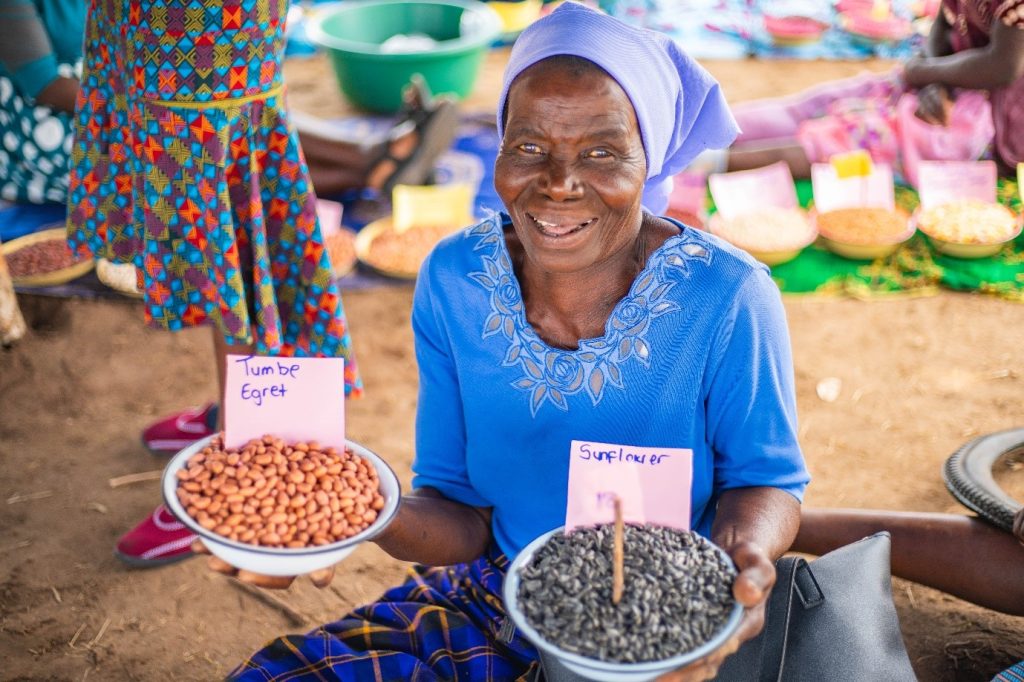
Farmers, stakeholders, and partners, including seed companies, Hamara Chicks, PHI Commodities, the International Livestock Research Institute (ILRI), BioHUB Trust (BHT), Kurima Machinery and Technology, and Zimplow Limited, participated in the Seed and Livestock Fair in the Mbire and Murewa districts of Zimbabwe, which showcased indigenous and improved seed varieties and different technologies to strengthen crop and livestock value chain systems.
Initiated by CIMMYT in 2022, as the CGIAR Initiative on Agroecology, these series of fairs have become instrumental in bringing agrodealers closer to farmers and showcasing sustainable technologies and innovations that have the potential to strengthen production systems. It was also an opportunity for the agroecology initiative team to provide feedback to farmers and stakeholders on ongoing activities and technologies that were being tested since the initiative’s inception in Zimbabwe. By adopting a multi-partner approach, these fairs bring local food systems actors together to ensure food and nutrition security and improved income for farmers.
“The agroecology initiative has been collaborating with an array of organizations and institutes that can support our mission towards promoting agroecology and improving farming production, including other CGAIR entities like IWMI and ILRI, Hamara Group, Ecolyfe, and PHI Commodities,” said Dorcas Matangi, research associate at CIMMYT.
This year’s edition of the seed and livestock fair “Fostering Synergies: Diverse Crops, Livestock and Inclusive Communities” advocated for enhancing synergies within the farm to foster sustainable agroecology transitions for resilient food and nutrition outcomes. With over 800 farmers and stakeholders participating, the event provided a vibrant platform for knowledge sharing, exploration of indigenous and improved seed varieties, and sensitization of innovative technologies.
“The seed and livestock fairs hosted by the agroecology initiative bring together farmers and food system actors from all walks of life to foster learning around agroecology, which includes the importance of diversity (crop and livestock) while also appreciating local innovations in the respective area,” said Jesca Mapfinya, a Murewa farmer.
The right seed, assures a good harvest
Various seed companies participated in the fair to showcase different seeds which are well adapted in Murewa and Mbire districts. Each agroecological region in Zimbabwe is unique, with adaptable seed varieties that are either landrace or improved. Local landraces and many underutilized crop species are adapted to weather and climate variability, climate change, and extreme weather such as drought and heat stress. Farmers indicated that their motivations for growing landraces are related to sustainable farming systems suitable for social, cultural, nutritional, and agronomic traits. Their place in rural communities remains important, providing much-needed functional diversity and social capital. Including improved varieties within the basket of options can further intensify production systems in these communities.
“Primarily, we sell seed varieties and build farmer capacity around appropriate agronomic practices. The seed fairs are a good platform to match seeds and systems and allows a farmer to provide feedback about our seed varieties and how they are performing in the respective areas,” said Onesmous Satenga, SeedCo.
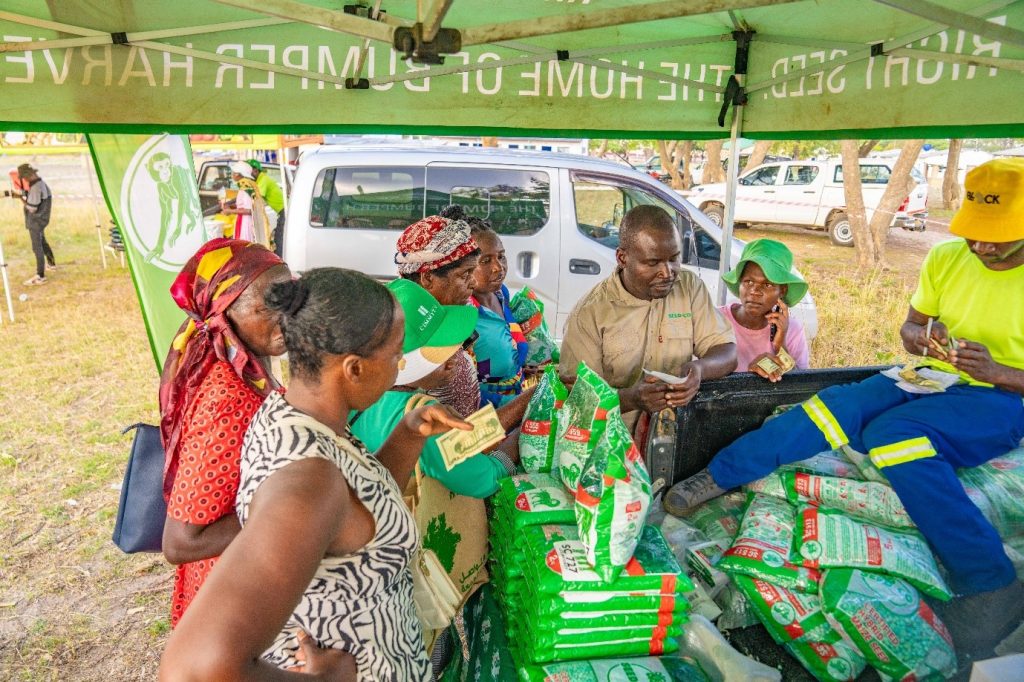
Building crop and livestock synergies
For the first time since the inception of the fairs, livestock such as cattle, sheep, goats, chicken and rabbits were displayed. Partners, including ILRI and the Hamara Chicks, who are into sasso chicken and feed production, reiterated the importance of crop diversity for improved livestock nutrition. ILRI and the Grasslands Research Institute exhibited various local feedstocks and alternative livestock feed grasses and also presented several feed formulations. Farmers also provided feedback on the feeding strategies employed for different livestock.
“We feed cattle with poultry litter, maize grain, maize stover, and groundnut shells in various proportions depending on the availability of these feed sources. Forage legumes such as velvet bean (mucuna pruriens) and lablab (lablab purpureus) have been introduced, and we have started to grow these for feed,” said Samson Tashaya, Murewa farmer.
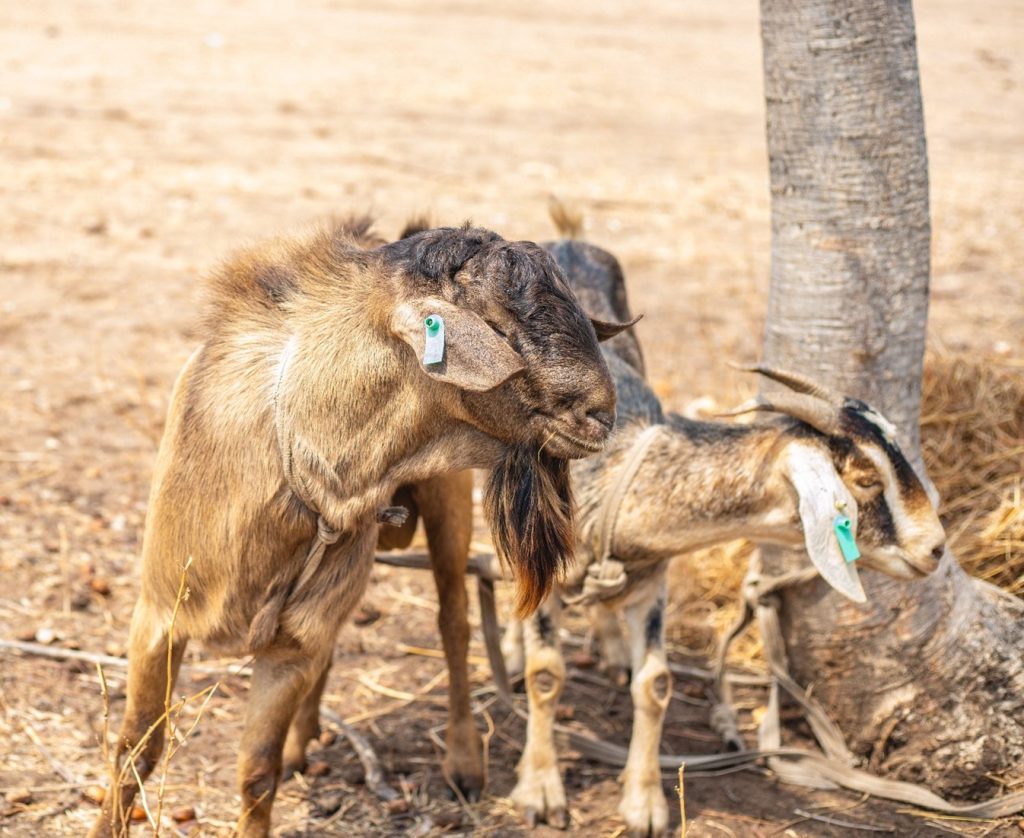
Of keen interest to farmers and stakeholders was the sasso breed of chickens that the Hamara Group was promoting.
“We have recently joined as partners with CIMMYT and are promoting hybrid chicken production, especially sasso, here in Murewa ward 27 and 4. This is our first time coming to this seed fair, and it was a learning opportunity. The interactions with farmers were really good,” said Alan Norton, team leader at Hamara Chicks.
Modernizing smallholder production systems
Mechanization experts from Kurima Machinery and Zimplow shared their recommendations at the fair. They acknowledged that farmers rely heavily on scarcely available labor and production activities that are backbreaking. They advocated for modern production systems to produce more food and support economic transformation. Experts from Kurima Machinery and Zimplow demonstrated several machines that could aid farmers in various on-farm activities.
“This fair has come at the right time as I begin land preparation for my pfumvudza (conservation agriculture plots). I have seen how the basin digger works, and I am keen to purchase an instrument to make my work much easier,” said Chief Chisunga, Mbire.
“This crop season’s outlook is still unclear, but weather experts have warned of an intense El Nino event likely to happen in the second half of the season. Technologies such as conservation agriculture can ensure good moisture retention in crop fields, and it needs to be paired with good agronomic practices,” said Tafadzwanashe Mabhaudhi, climate and food systems expert.
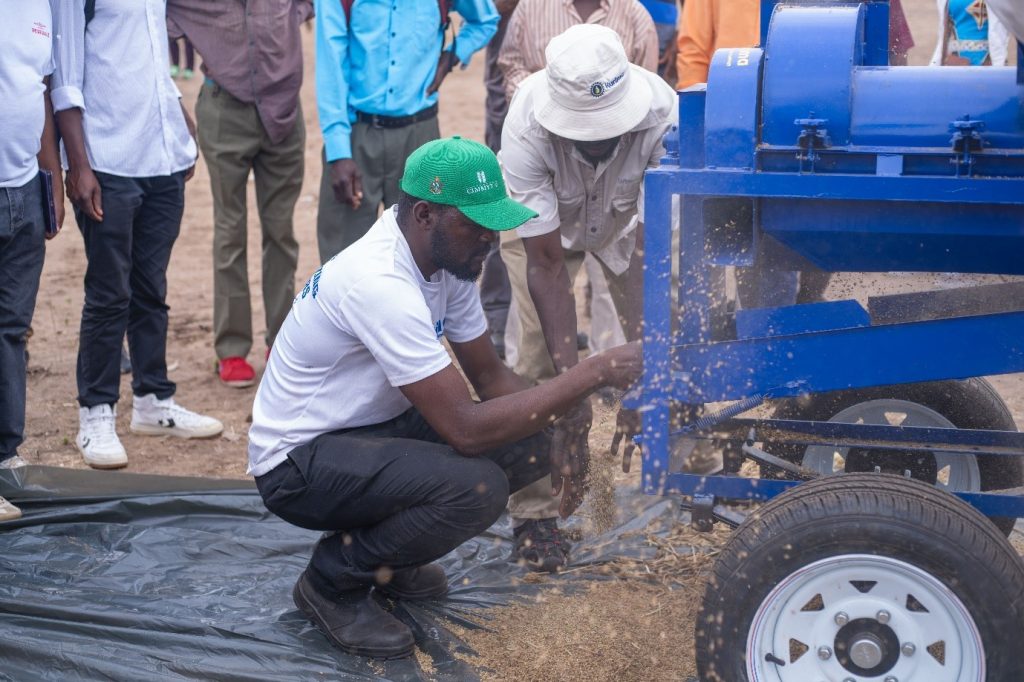
CIMMYT Director General, Bram Govaerts, praised China’s recent efforts to curb its reliance on food imports and increase funding for technology-driven breeding techniques, including gene editing. Govaerts suggested such measures have managed to shield China from the unfolding global food crisis that is caused by a mix of factors such as regional conflicts, climate change and rising protectionism.
Read the full article.
CIMMYT Ethiopia signed a memorandum of understanding (MoU) in November 2023 with the Addis Ababa-based private food processing company Alvima Foods Complex Plc, in an effort to encourage durum wheat production among smallholder farmers and create market linkage in selected woredas of Oromia and Amhara regional states.
The MoU, which is part of CIMMYT Ethiopia’s overall durum wheat project aiming to reinvigorate durum wheat production in the country, was signed by Workneh Rikita, Alvima general manager, and Kindie Tesfaye, CIMMYT Ethiopia’s senior scientist.
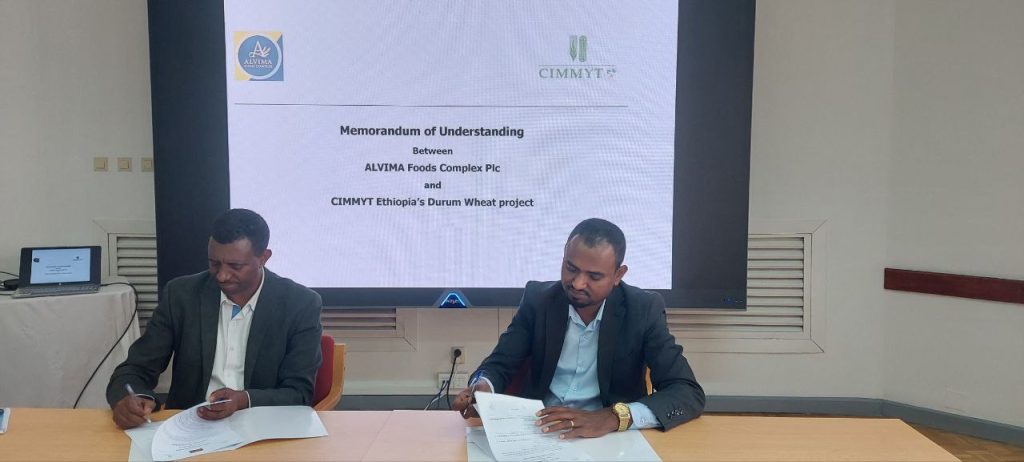
The MoU aims primarily to create market linkage between farmers and manufacturers, in a context of a sharp decrease of durum wheat production. “Prior to the 1980s, 80% of the wheat produced in Ethiopia was durum, but in 2016 our nationwide research on wheat showed that the durum wheat coverage was 5%, which stands in contrast to the country’s effort to industrialize the economy and substitute import goods with local produce”, said Kindie Tesfaye, CIMMYT durum wheat project leader. “We, as CIMMYT, want to encourage farmers to produce good quality durum wheat in quantity, and teach them about contract farming by creating market linkage with produce receivers like Alvima.”
“Cooperation, not business venture”
Established in 2011, Alvima Foods Complex initially centered its operations around importing and exporting agro-food products. In 2017, the company set up a pasta and flour processing factory and contracted 800 farmers to produce durum wheat. “At first, our objective was to produce premium quality pasta, unlike most processing companies in the country which produce pasta from hard wheat or mixed wheat,” said Workneh Rikita, Alvima’s general manager. In the absence of binding rules, the project failed and Alvima resigned to import durum wheat. “The law on contract farming was constituted recently and the difficulties to access foreign currency (therefore to import goods), which led us to turn our attention back to our initial project”, said Workneh Rikita.
Alvima Foods Complex general manager added that his company didn’t sign the agreement as a business venture but as an advantageous cooperation to learn from. He thanked CIMMYT for agreeing to work with his company and expressed his hopes for its success.
The current durum wheat market in Ethiopia is unpredictable as prices are set by the brokers, which heavily disadvantages the growers. The objective of the memorandum of understanding is to address such market challenges faced by farmers, affording them guaranteed market opportunities at a fair price.
As part of the agreement between Alvima Foods Complex and the durum wheat growers in target districts of the Amhara and Oromia regional states, CIMMYT will leverage on its expertise to help the farmers produce more and in good quality. Alvima will access the produce from farmers’ cooperatives directly, without the intervention of middlemen, to guarantee better incomes to producers. Moreover, CIMMYT is training farmers on use of climate information, accessing climate advisories, video-based production trainings, and crop disease management.
“If the farmers get the premium price for their produce, they will be encouraged to continue producing better wheat,” said Kindie Tesfaye. “We want the cooperation to be sustainable and to create direct links between farmers and local food processors (such as AVLIMA). The MoU will also benefit Ethiopia by decreasing imports of processed food items.”
A multilayered challenge to durum wheat production
Supported by the Bill and Melinda Gates Foundation, CIMMYT and Digital Green (an organization creating digital tools to assist farmers) have been conducting durum wheat improved varieties were insufficiently promoted; the seed was not made adequately accessible to farmers; productivity was perceived by farmers as being low; and market linkage was poor. These multilayered challenges led farmers to prioritize bread wheat varieties, according to Kindie Tesfaye.
In response, CIMMYT structured its support around three main pillars: the organization helps farmers access seeds together with Oromia’s Seed Enterprise, provides farmers with digital advisory services to improve their productivity, and works with the private and public sectors to upgrade market linkages, as with the memorandum of understanding signed with Alvima Foods Complex Plc.